Maurice Goldhaber
This articleneeds additional citations forverification.(February 2013) |
Maurice Goldhaber | |
|---|---|
 | |
| Born | April 18, 1911 |
| Died | May 11, 2011(aged 100) |
| Alma mater | University of Berlin Cambridge University |
| Known for | Neutrinosand negativehelicity |
| Awards | Tom W. Bonner Prize in Nuclear Physics(1971) National Medal of Science(1983) Wolf Prizein Physics(1991) J. Robert Oppenheimer Memorial Prize(1982) Fermi Award(1998) |
| Scientific career | |
| Fields | Physicist |
| Institutions | Cavendish Laboratory |
| Doctoral advisor | James Chadwick |
Maurice Goldhaber(April 18, 1911 – May 11, 2011) was an Americanphysicist,who in 1957 (withLee Grodzinsand Andrew Sunyar) established thatneutrinoshave negativehelicity.
Early life and childhood[edit]
He was born on April 18, 1911, inLemberg,Austria,now calledLviv,Ukraineto a Jewish family. His great-grandfather Gershon Goldhaber was a rabbi.[1]His son Alfred Goldhaber is a professor at theC. N. Yang Institute for Theoretical Physicsat SUNY Stony Brook. His grandson, David Goldhaber-Gordon is a Physics Professor atStanford University.
Education[edit]
After beginning his physics studies at theUniversity of Berlin,he earned his doctorate atCambridge Universityin 1936, belonging toMagdalene College.
Career[edit]
In 1934, working at theCavendish LaboratoryinCambridge, Englandhe andJames Chadwick,through what they called the nuclear photo-electric effect, established that the neutron has a great enough mass over the proton to decay.
He moved to theUniversity of Illinoisin 1938. In the 1940s with his wifeGertrude Scharff-Goldhaberhe established that beta particles are identical to electrons.
He joinedBrookhaven National Laboratoryin 1950. WithEdward Tellerhe proposed that the so-called "giant-dipole nuclear resonance" was due to the neutrons in a nucleus vibrating as a group against the protons as a group (Goldhaber-Teller model).
He made a well-known bet withHartland Snyderin about 1955 thatanti-protonscould not exist; when he lost the bet, he speculated that the reason anti-matter does not appear to be abundant in the universe is that before theBig Bang,a single particle, the "universon" existed that then decayed into "cosmon" and "anti-cosmon," and that the cosmon subsequently decayed to produce the known cosmos. In the 1950s also he speculated that allfermions[2]such aselectrons,protonsandneutronsare "doubled," that is that each is associated with a similar heavier particle. He also speculated that in what became known as the Goldhaber-Christie model, the so-calledstrange particleswere composites of just 3 basic particles. He was Director ofBrookhaven National Laboratoryfrom 1961 to 1973.
Among his many other awards, he won theNational Medal of Sciencein 1983,[3]the Golden Plate Award of theAmerican Academy of Achievementin 1985,[4]theWolf Prizein 1991, theJ. Robert Oppenheimer Memorial Prizein 1982 (shared withRobert Marshak),[5]and theFermi Awardin 1998. He was an elected member of the United StatesNational Academy of Sciences,[6]theAmerican Academy of Arts and Sciences,[7]and theAmerican Philosophical Society.[8]
Maurice Goldhaber's brotherGerson Goldhaberwas a professor of physics at theUniversity of California Berkeley;his son Alfred Scharff Goldhaber is a professor of physics atSUNY Stony Brook;his grandson (son of Alfred) David Goldhaber-Gordon is a professor of physics atStanford.
Death[edit]
Goldhaber died May 11, 2011, at his home inEast Setauket,New Yorkat 100.[9]
Legacy[edit]
In 2001,Brookhaven National Laboratorycreatedthe Gertrude and Maurice Goldhaber Distinguished Fellowshipsin his honor. These Fellowships are awarded to early-career scientists with exceptional talent and credentials who have a strong desire for independent research at the frontiers of their fields.[10]
References[edit]
- G. Feinberg, A.W. Sunyar, J. Weneser,A Festschrift for Maurice Goldhaber,New York Academy of Sciences (1993),ISBN0-89766-086-2
- ^"Biographical Memoir of Maurice Goldhaber"(PDF).
- ^Goldhaber, Maurice (2002), "A closer look at the elementary fermions.",Proc. Natl. Acad. Sci. U.S.A.,vol. 99, no. 1 (published Jan 8, 2002), pp. 33–6,arXiv:hep-ph/0201208,Bibcode:2002PNAS...99...33G,doi:10.1073/pnas.221582298,PMC117509,PMID11773637
- ^Maurice Goldhaber at the President's National Medal of Science
- ^"Golden Plate Awardees of the American Academy of Achievement".achievement.org.American Academy of Achievement.
- ^"Oppenheimer Prize awarded to Goldhaber and Marshak".Physics Today.35(9). American Institute of Physics: 89. September 1982.Bibcode:1982PhT....35i..89..doi:10.1063/1.2915276.
- ^"Maurice Goldhaber".nasonline.org.Retrieved2022-08-18.
- ^"Maurice Goldhaber".American Academy of Arts & Sciences.Retrieved2022-08-18.
- ^"APS Member History".search.amphilsoc.org.Retrieved2022-08-18.
- ^Kenneth Chang (2011-05-17)."Maurice Goldhaber, Atomic Physicist, Is Dead at 100".New York Times.Retrieved2011-05-18.
Dr. Goldhaber was director of the Brookhaven lab from 1961 to 1973, overseeing experiments there that led to three Nobel Prizes. His most famous contribution to science's basic understanding of how the universe works involved the ghostly, perple xing subatomic particles known as neutrinos.
- ^Goldhaber Distinguished Fellowships
External links[edit]
- BNL celebrates Goldhaber's 90th year
- Description of Goldhaber's spinning neutrino experiment
- Biography of Maurice Goldhaber at Fermi Award website
- Oral History interview transcript with Maurice Goldhaber 10 January 1967, American Institute of Physics, Niels Bohr Library and ArchivesArchived12 January 2015 at theWayback Machine
- 1911 births
- 2011 deaths
- American nuclear physicists
- Austrian physicists
- Austrian nuclear physicists
- National Medal of Science laureates
- Enrico Fermi Award recipients
- Wolf Prize in Physics laureates
- Jews from Galicia (Eastern Europe)
- Austrian Jews
- American people of Austrian-Jewish descent
- Scientists from the Kingdom of Galicia and Lodomeria
- Scientists from Lviv
- Alumni of Magdalene College, Cambridge
- Brookhaven National Laboratory staff
- American men centenarians
- Austrian centenarians
- Members of the United States National Academy of Sciences
- People from East Setauket, New York
- Jewish American physicists
- Scientists from New York (state)
- 21st-century American Jews
- Austrian emigrants to the United States
- Members of the American Philosophical Society
- Presidents of the American Physical Society
- Jewish centenarians
